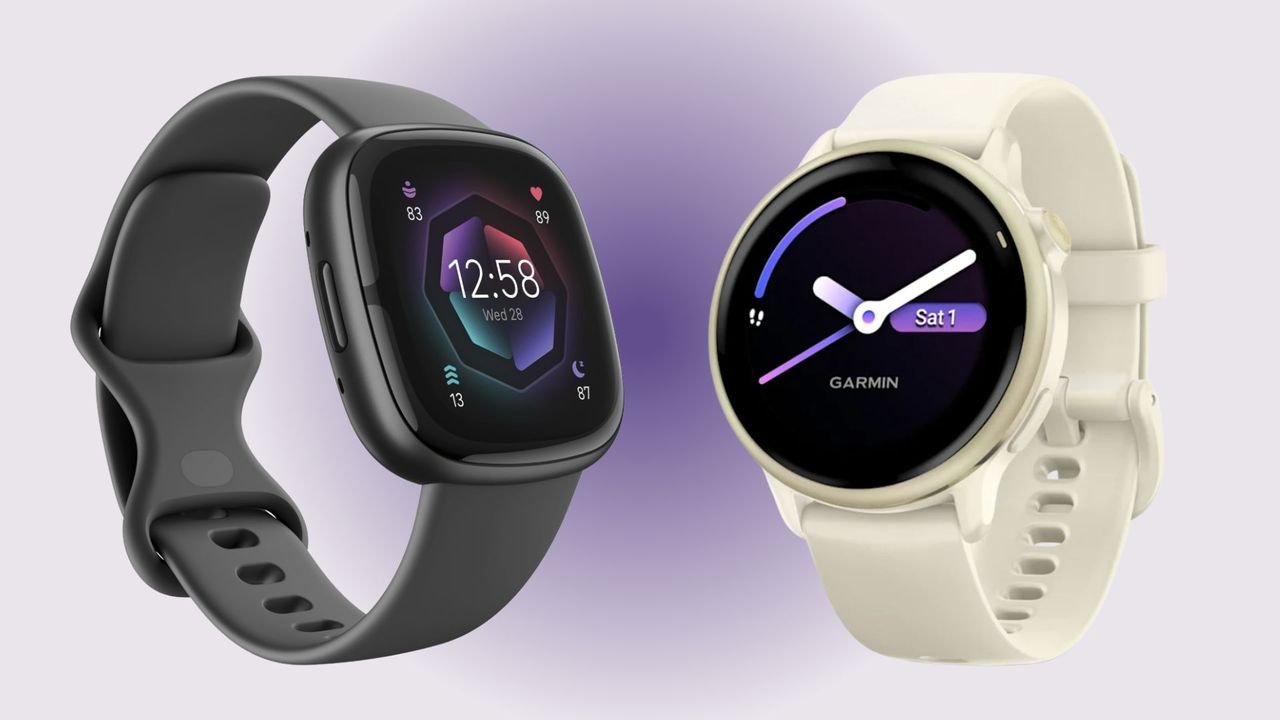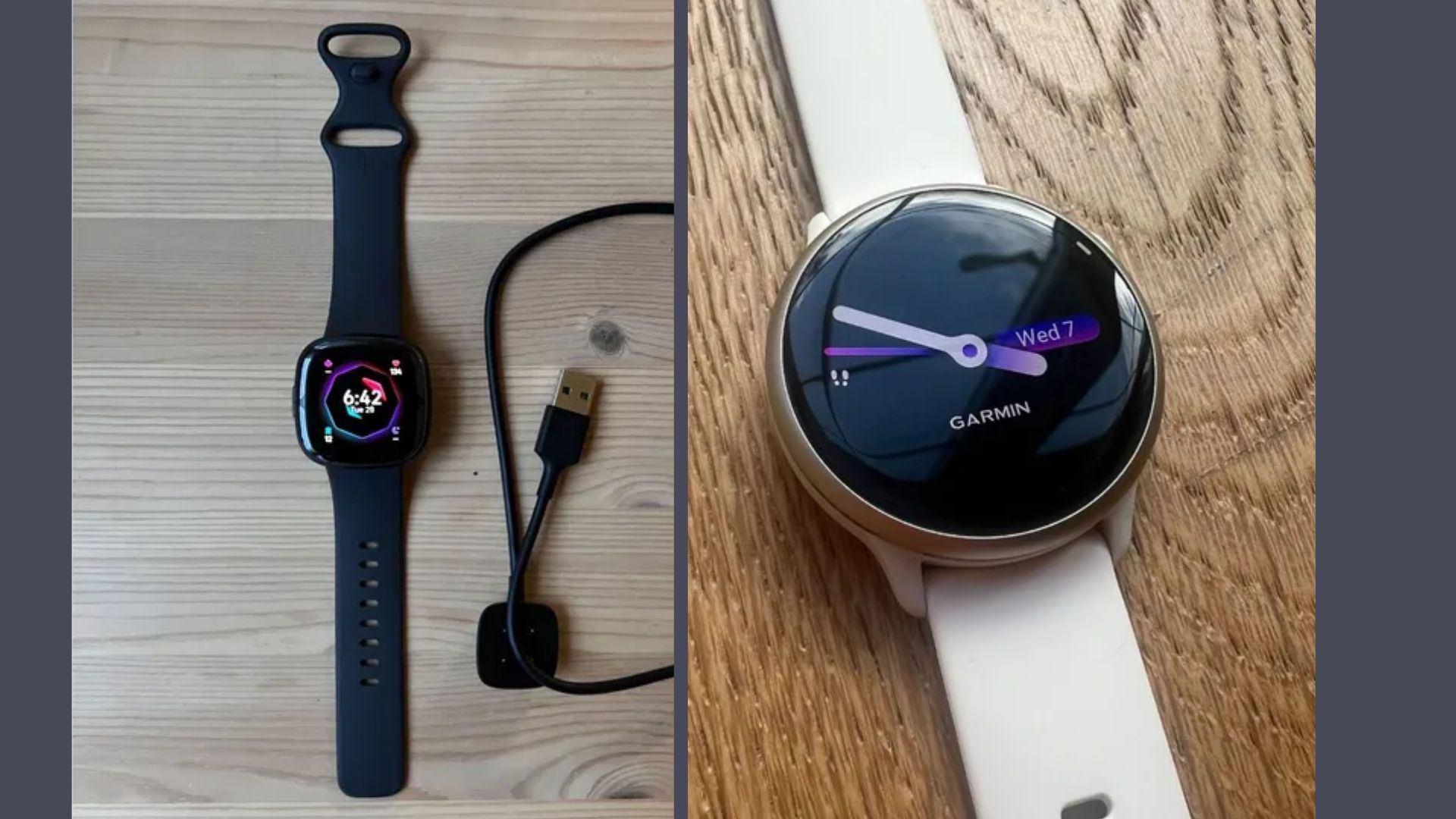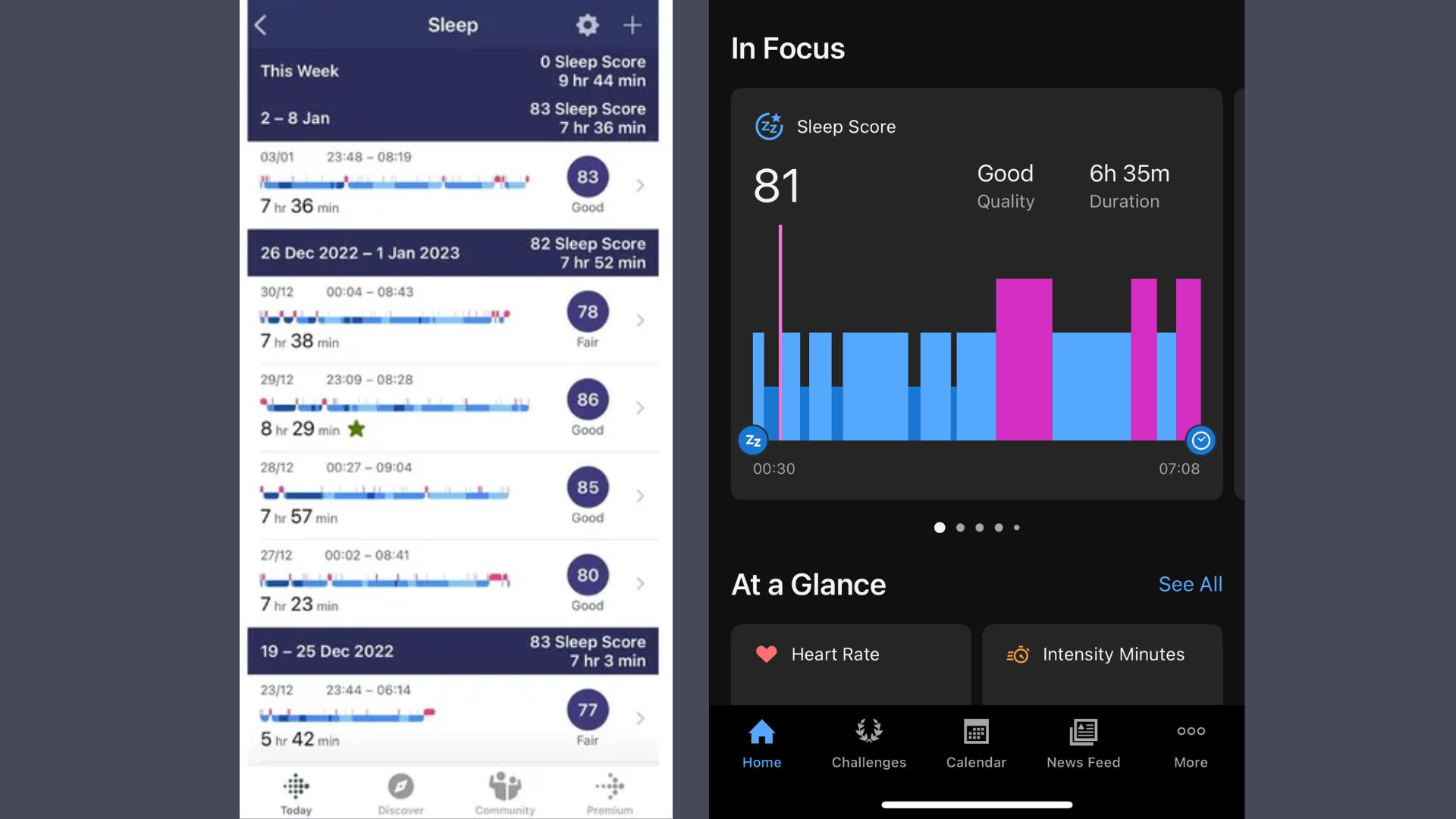
If you're in the market for a new fitness tracker, you've probably thought about the positives of buying a Garmin vs Fitbit watch. As two of the largest brands, they both sell a range of devices designed to suit various lifestyles and wellness goals.
As woman&home's digital health editor, I've tried my fair share of the best fitness trackers. Fitbit and Garmin devices are among my favourites, thanks to the superb data on fitness, sleep, and stress, sleek designs, and smartwatch features. With so many choices between them, though, it can be difficult to find your best Garmin watch or the best Fitbit for you.
To help you decide between Garmin vs Fitbit, I've weighed up two of the latest models: The Fitbit Sense 2 and the Garmin Vivoactive 6. I love both of these watches, so whether you're aiming to get your step count up or you're training for something special, you'll be covered with both of these. However, you only need one. Here's how to decide between the two...
Garmin vs Fitbit
Overview of Garmin vs Fitbit
First things first, there have been fewer new devices from Fitbit since Google bought out the brand in 2021. Most of the Fitbit technology (including the app) is now included in Google's own line of fitness trackers - including the Google Pixel 3.
This is not a bad thing - the Google Pixel watches are excellent and I'd recommend them to anyone. However, it does mean that while Garmin has stormed ahead with features, sensors, and smartwatch capabilities even on more budget-friendly devices like the Garmin Vivoactive 6 or Forerunner 55, Fitbit has been slow to grow.
Last year, Google announced there would be no more Fitbit smartwatches (like the Sense 2 or Versa 4), but new fitness trackers (like the Charge 6) would be released.
That being said, as of October 2025, I still recommend the Fitbit Sense 2 as the software and security are still being updated. The watch remains a serious contender with excellent fitness insights, built-in GPS, smartwatch features, and health sensors, so it's worth weighing up Garmin vs Fitbit before making a decision.
Available in cool neutrals like black and cream to unique dark green colourways, the Vivoactive 6 makes for a sleek fitness tracker. Made of polymer (plastic) and aluminium, it's also lightweight.
Read my full Garmin Vivoactive 6 review here
Much like the Vivoactive 6, the Sense 2 comes in calming colourways - including a light blue I've not seen elsewhere. It's also made with polymer and aluminium around the bezel, but it's even more lightweight than the Garmin at 24g.
Read my full Fitbit Sense 2 review here
Design of Garmin vs Fitbit
Putting the Garmin Vivoactive 6 and Fitbit Sense 2 side by side, they look almost the same - apart from the shape of the watch face. The Vivoactive 6 has a round design, similar to other Garmin watches (aside from the Garmin Venu Sq2) and the Sense 2 has a square-faced design.
Otherwise, they are very similar. Both have at least one (the Vivoactive has two) raised side button that brings the screen to life and navigates to and from the home screen, an aluminium bezel surrounding a bright AMOLED screen, and a silicone strap.
You'll also find these watches come in similar neutral colours, with the option of a sleek dark green in the Vivoactive 6. I love this colourway and I haven't seen it built into a product like this before.
Winner: It's down to personal preference.

Fitness tracking
If you're just looking to get your steps in, start running, go to the gym more often, or keep an eye on your health, either of these watches is a great choice. You'll be able to start workouts from running to Pilates with the touch of a button, receiving on-wrist insights into your session at the end, which are then transferred to the Garmin Connect and Fitbit apps, respectively.
Both watches will automatically start recording a workout if you forget to start it manually as well, a feature I've found very helpful in the past when I've set out excitedly on a run, only to forget about my watch.
However, if you're looking to go beyond the basics, the Garmin Vivoactive 6 is the clear winner. While both watches will record your workouts so you can find out how fit you are, only the Vivoactive 6 will help you take steps to improve your fitness.
The key way it does this is through the Training features. When starting a workout on the Vivoactive 6, you'll get a daily suggested workout tailored to that activity (e.g. Brisk Interval Walk, 20 minutes), be able to set a target pace and/or distance, view and start pre-made workouts from the Garmin Connect app, and even race against a previous time.
Winner: Garmin Vivoactive 6
Sleep and health sensors
When it comes to sleep tracking, the Fitbit Sense 2 and the Vivoactive 6 have similar offerings. For example, both will record sleep provided you wear the watch to bed. In the morning, you'll get an overview of your sleep - including the duration, quality, and your Sleep Score, which is out of 100.
Both also offer a rundown of your sleep in the long term via Sleep Alignment on Garmin (after three weeks of use) and Sleep Profile on Fitbit (after 14 days of use, but you need to subscribe to Fitbit Premium to access it). With these features, you can get a good idea of your circadian rhythms and learn how to sleep better by working with your body's natural timings.
They are fairly similar, but you may want to consider the additional £7.99 cost of needing to subscribe to Fitbit Premium. By the time you've done that for a few months, you may have paid the difference between the Garmin vs Fitbit.
Body Battery is another feature I love on the Garmin Vivoactive 6. This simple recovery metric uses your fitness, sleep, recovery, and other metrics to determine how ready you might be for movement on any given day. While you should always listen to your body, I've found it to be a handy tool to push myself on days when I've felt demotivated.
There's a very similar feature in the Fitbit Premium app called Readiness Score. It takes the same data from the Fitbit Sense 2 and lets you know how 'ready' your body may be for exercise. Much like the Sleep Profile, you'll need a Fitbit Premium subscription to get this feature.
Both the Vivoactive 6 and the Sense 2 have an electrocardiogram (ECG), which is not a medical device but can be used to detect signs of atrial fibrillation (irregular heartbeat) that can be shared with your doctor.
Winner: Equal - but the Garmin Vivoactive 6 doesn't require a subscription
Many more advanced trackers, like the Oura Ring 4, offer similar features. So, if sleep is a priority for you, be sure to weigh up the Oura Ring vs Garmin before making a decision.

Smartwatch features on the Garmin vs Fitbit
While the Garmin Vivoactive 6 is a fitness tracker with smartwatch features, the Fitbit Sense 2 is sold as a smartwatch. So, it makes sense that it has more lifestyle features. For the most up-to-date Garmin smartwatch, I'd recommend the Garmin Venu 4 or the Venu X1, which is most similar to the Apple Watch.
However, on both the Vivoactive 6 and the Sense 2, you can receive call and text notifications, use your watch to pay via Garmin Pay or Google Wallet, view upcoming events in your calendar, and check the weather.
The Fitbit Sense 2 also has unique integration with Google's Alexa, so you can navigate around your watch without having to touch the screen at all. During the winter, I've found this particularly useful for starting and stopping workouts without taking my gloves off.
One of the big improvements on both the Vivoactive 6 and the Sense 2 from previous models is the mapping features. On the Fitbit, you'll be able to utilise Google Maps on your wrist (after setting your destination in your phone's app) with turn-by-turn navigation during workouts and regular life. It's a lifesaver when you're navigating a busy city and don't want to get your phone out or follow a route on your daily walk.
On the Garmin, you'll have to start a workout (walking, running, cycling, etc) to enable the mapping features, which offer turn-by-turn navigation and the chance to follow a route you've done before. You can't use it regularly on your wrist, unlike the Fitbit.
However, you can connect to your music streaming service (Spotify, Amazon Music, or Deezer) via the Vivoactive 6, so you can leave your phone at home on a run, walk, or bike ride and still listen to music through your best exercise headphones. The Sense 2 doesn't have this feature.
Winner: Fitbit Sense 2
Price of the Garmin vs Fitbit
The Fitbit Sense 2 is £219.99 on Amazon and the Google website, while the Garmin Vivoactive 6 is £279.99 on the brand's website and third-party retailers like Amazon, unless you can find a saving in the Garmin sale.
This makes the Fitbit Sense 2 the most budget-friendly option, and I think it's a great investment if you're looking to cover the basics with an all-around approach to your health and wellbeing. Many watches that don't have an ECG or skin temperature sensor are double the price of this one.
Winner: Fitbit Sense 2
Garmin vs Fitbit: Which is better?
Overall, I'd recommend the Garmin Vivoactive 6 over the Fitbit Sense 2 if your budget can stretch and you're looking for a fitness tracker rather than a smartwatch. It has significantly more fitness, sleep, recovery, and stress insights that'll help you build better habits and look after your existing ones. These insights are also all available within the watch, with no extra fees.
The Fitbit Sense 2 becomes a lot more basic when you take away the Fitbit Premium access, which you have to pay £7.99 a month for.
That being said, it'll be all you need if you're new to exercise or just looking to do a couple of workouts and count your steps. As one of the newer Garmin models, the Vivoactive 6 may have features you don't think you'll use.







